Bullet Journaling 101: The Ultimate Setup Guide for Beginners
Wondering how to start a bullet journal? This all-in-one, customizable notebook will radically change how you approach your days. You may never go back to a traditional planner!
Over seven years ago, I started my first bullet journal.
I’ve always been a list maker, notebook hoarder, and a little (okay plenty) obsessed with my favorite pens. But my lists were all over the place and a number of half-filled notebooks lined my office shelves.
This site is reader-supported. When you purchase through our links, we may earn an affiliate commission.
I distinctly remember opening my Instagram app one day and spotting a hand drawn weekly layout, similar to one you’d find in a traditionally designed planner.
Except, this was just a simple notebook, NOT a planner.
Later, I found out this notebook was called a bullet journal. Or “bujo” for short.
Immediately, I wanted to learn everything about this customized, yet functional planning system. Because the truth was, I could never find a planner that fit my needs. The layouts just didn’t work with my brain. Plus, some of them are so expensive! $70 for a planner? Really?
Of course, I fell down the hashtag rabbit hole of #bulletjournaljunkies and #bulletjournallove trying to soak in everything I could about the bullet journal system before I started my own.
What is a Bullet Journal?
The Bullet Journal method was invented by Ryder Carroll in 2013. It is unique because it puts the power of using what planning system works for you into your own hands. You decide what and how you organize your personal (or even your business!) life by tailoring a blank notebook to fit your unique lifestyle or planning needs.
That means you don’t have to sift through all the things you don’t want or need in a planner and can focus just on what you will actually use!
Because the layout is so customizable, you can easily switch things up if something doesn’t end up working for you long term. There so many helpful tutorials for bullet journal beginners to help you get some ideas of what you’d like to try, and you can find a lot of fun inspiration for bullet journal spreads across blogs and social media to really give you a grasp on the full potential of bullet journalling.
All you need to get started is a blank notebook (here’s how to find the best one!) and a favorite pen. Then you can track whatever you want to track—from meal planning to budgeting to your day-to-day tasks—making it as complicated or as simple as you like.
Bullet journals are broken down into a few categories—A ‘key’, ‘daily log’, ‘monthly log’, ‘future log’, and an ‘index’. We’ll be going more in depth into each of these as we discuss the bullet journal setup!
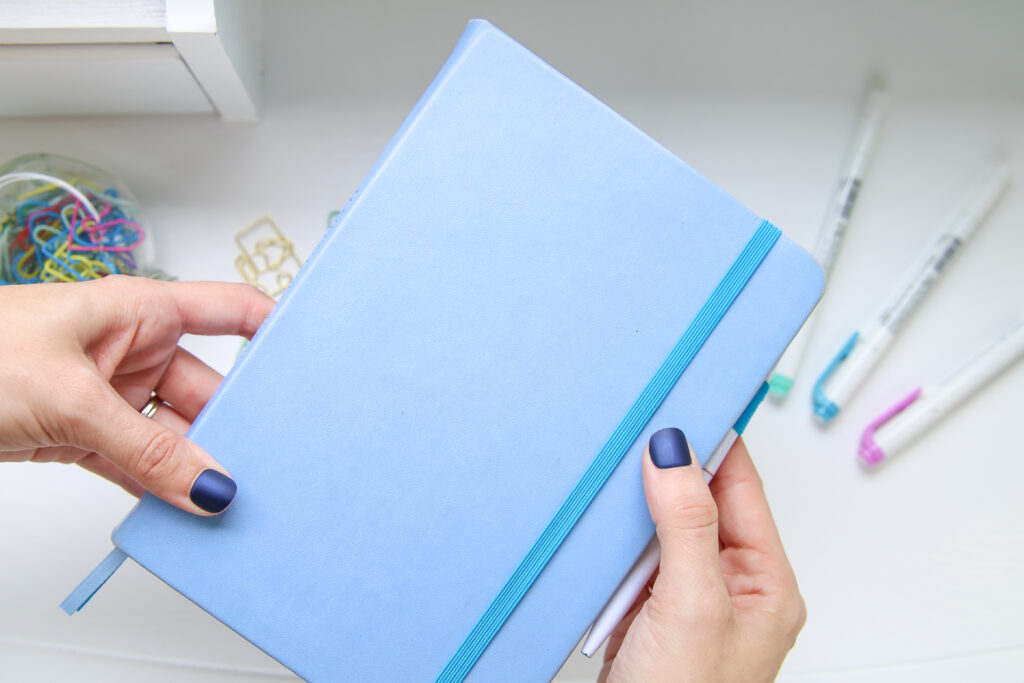
Is Bullet Journaling Worth it… or a Waste of Time?
Sometimes, individual bullet journal pages look like a professional art piece. But you have to remember that you are literally customizing a planner from scratch. I first thought this hobby had the potential to be more of a time-waster than a time-saver.
It honestly depends on how much time you spend on your bullet journal.
If you enjoy drawing new layouts, doodling, hand lettering, and adding multiple stickers and layers of washi tape to your pages, then yes, you’ll spend some time setting up your bullet journal. But the people who do this are generally individuals who like expressing themselves through this creative outlet.
Bullet journaling is their hobby and a way to take care of their mental health.
But you can also keep a minimalistic bullet journal with very few colorful pens, stickers, or drawn-out designs. There are no rules!
In fact, the way I bullet journal now looks vastly different than what I did in my first handful of notebooks. Instead of drawing an involved weekly layout where I needed a ruler, highlighter, and lots of colored pencils, I rely solely on daily lists and do the majority of my project and task planning in Notion!
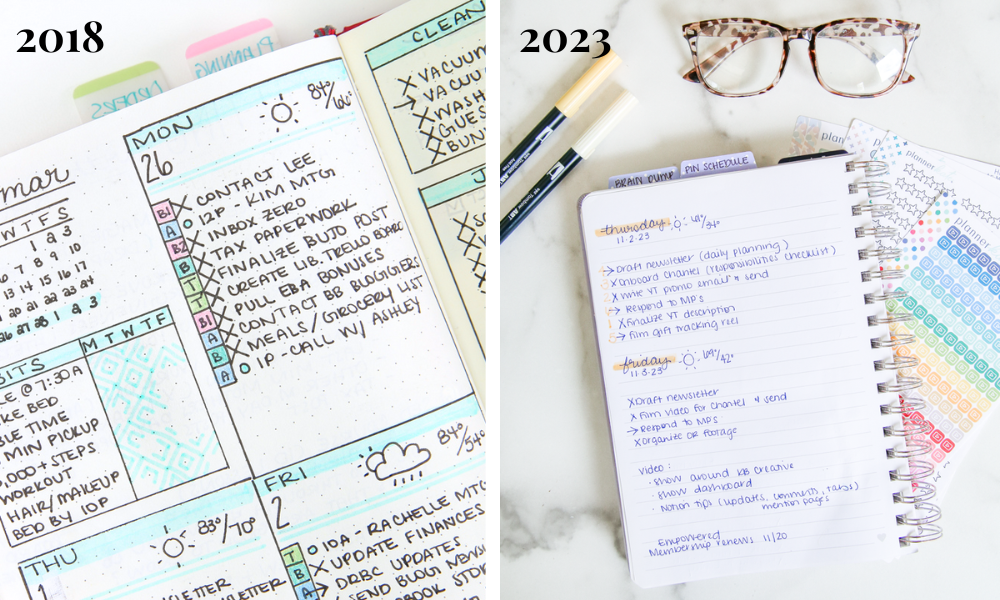
Overall, your bullet journal should work exactly as you need it to, which means you don’t have to waste time squeezing yourself into planner boxes that don’t work.
And if you don’t like to draw, you don’t have to! You can easily create a pre-made bullet journal inside a ring or discbound notebook by using planner inserts. The Brainbook Printable Library provides over 250 designs to choose from and you can easily switch pages out when you want to try something new!
Supplies You’ll Need
Remember, you only need a notebook and a pen! But some additional items would be helpful to have on hand. Reference this post for an entire breakdown of recommended bullet journal supplies.
The Main Elements of a Bullet Journal
If you’re wondering how to start a bullet journal, you need to understand a few terms first.
1. Key
Every bullet journal needs a good key. This is your own “personal code” of sorts that allows you to spend less time manually writing out lengthy words or tasks that you repeat often by using a symbol or color instead.
It’s an essential part of rapid logging, which is a shortcut to creating bullet point lists by eliminating the need to write out everything. You can see at a glance what is going on in your day.
They key is usually put near the beginning of the Bullet Journal to make it easy to refer to. And as with everything else, this is entirely customizable to fit exactly what you need.
If you only need one or two keys, or if you need a dozen, you get to decide what is relevant and what will help you when you create your lists each week. You can use colors, symbols or even stickers to set up your key, but it’s good to pick something that’s easy for you to replicate over time!
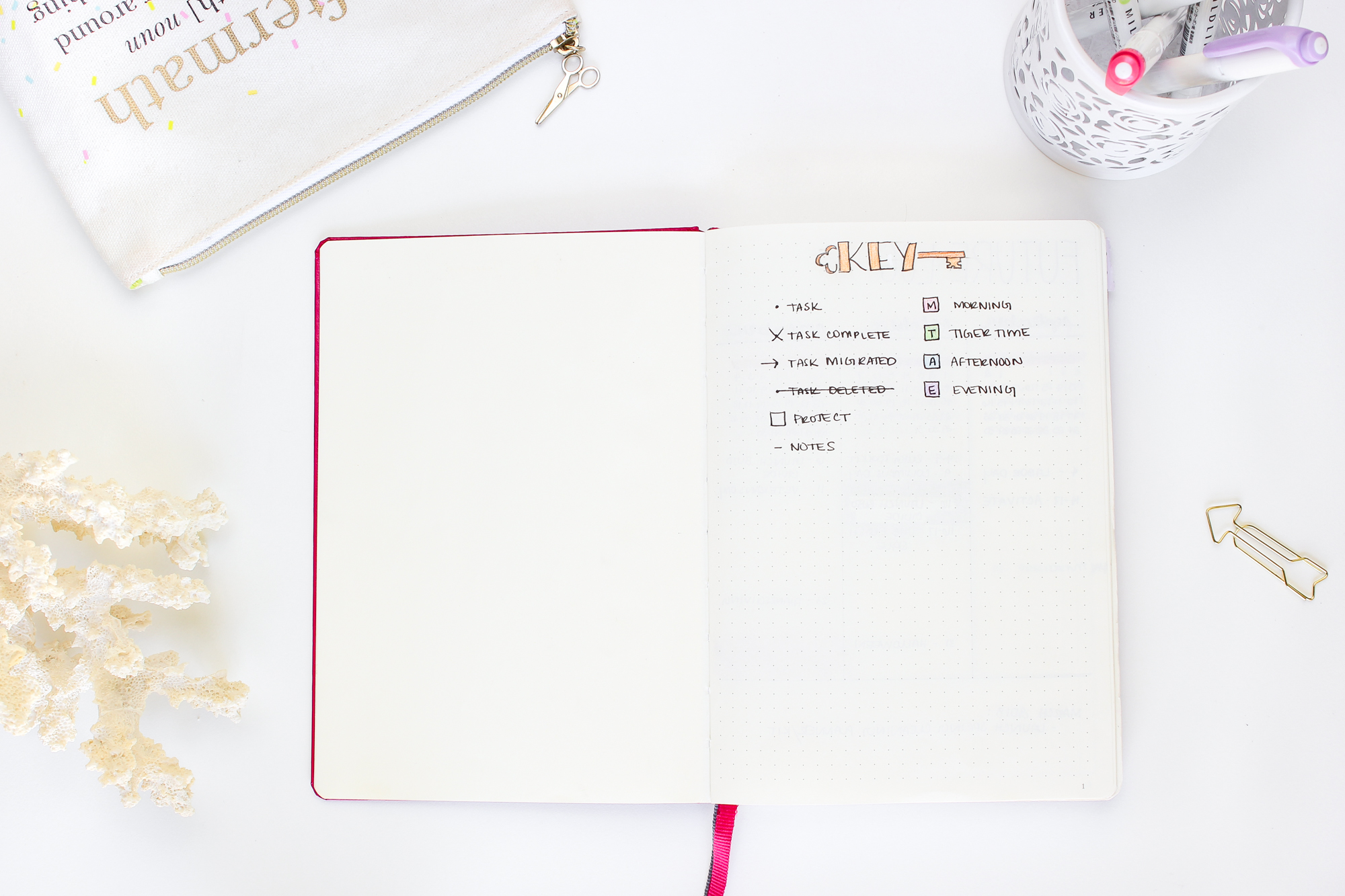
2. Index
The Index page is the organizing glue that holds your entire bullet journal together. Kind of like a table of contents. You can either use a notebook with pre-numbered pages (like the Leuchtturm1917) or number the pages yourself. Then you just write down the topic of each page in the Index along with the corresponding page numbers of that topic.
When you need to locate a specific note or collection and you’re 50+ pages in, all you have to do is flip back to the Index to find it!
Even if you don’t keep a bullet journal long term, you’ll find yourself using the index method for any notebook from now on. It’s so useful!

3. Future Log
Because you create each page as you need it in your Bullet Journal, you don’t have the ability to flip months in advance to add in upcoming important dates or things you need to remember say, six months from now because those pages aren’t even created yet.
The solution to this in bullet journaling is the Future log. This is a page in the front of your journal with the entire calendar year. When you set an appointment or make a plan for a future date, you’ll simply flip to this page and write the important date at the bottom. This is the spot you’ll refer to each month as you are setting up that monthly layout so that you can include those in your schedule.
Using the future log in this way doesn’t really work for me. I prefer Google Calendar to time block and to keep track of important dates. A digital app is much easier to refer to when I am setting up my monthly and daily pages.
If you decide you want to use the traditional future log in your bullet journal, you can either handwrite your calendar or use an adorable monthly calendars sticker!
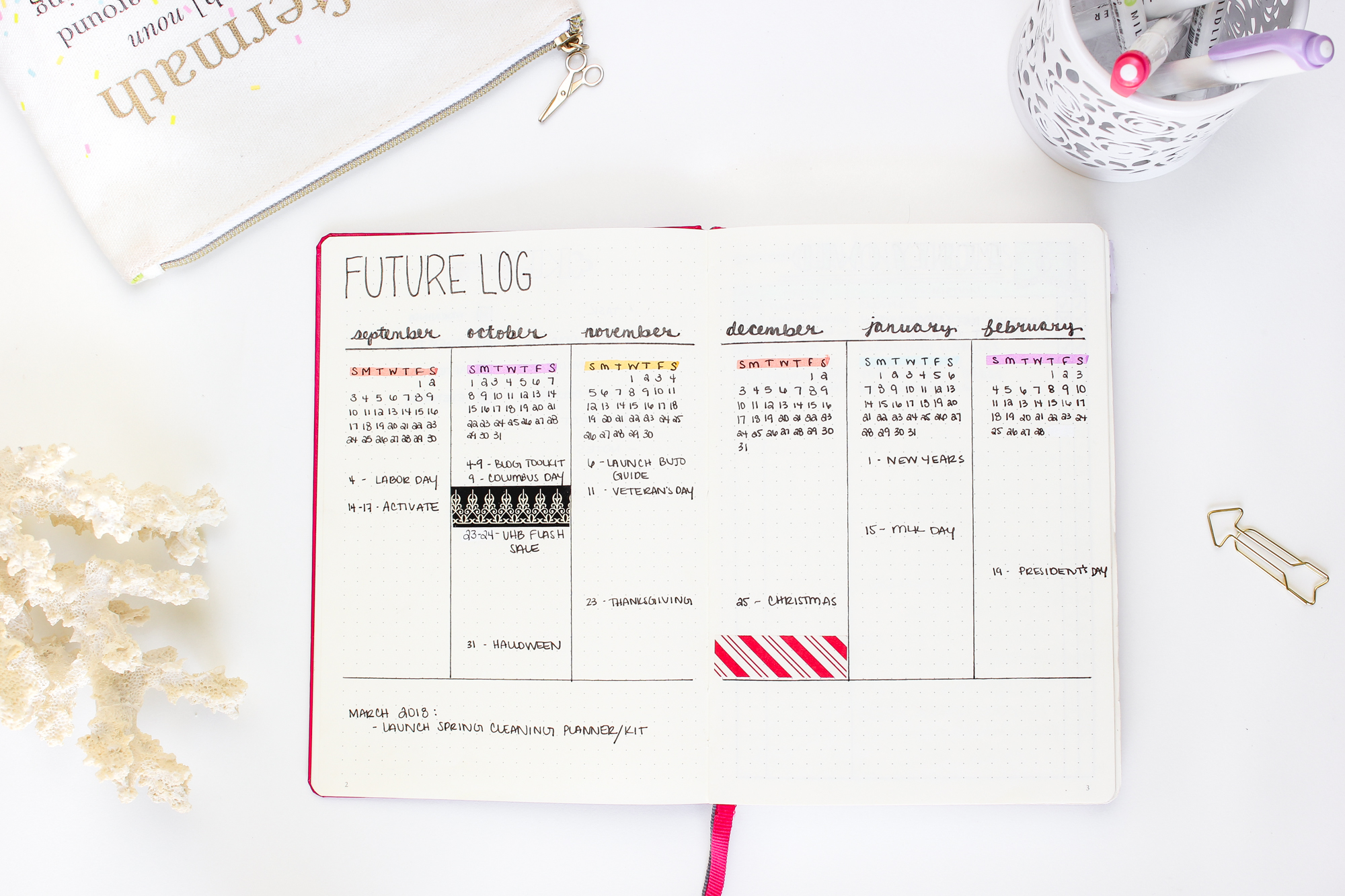
4. Monthly Log
At the end of each month, you’ll want to set up your next monthly log.
Open your bullet journal so you have two blank pages, and start that month’s calendar on the left page, leaving the right page as space to record your monthly tasks or monthly goals. You’ll be able to refer to your future plans page (or an online calendar, if you use that.) to fill in any important appointments or deadlines and can easily see at a glance what is coming up in your month.
The traditional monthly log is a linear method. To do this, you’ll list the days of the month down the left side of the page, creating line breaks to separate the weeks. This is just one way of setting up your monthly log, though.
Some people prefer to use a traditional calendar style page, where each day has it’s own box to write in. If you aren’t sure which one you’ll like better, experiment with both ways and see which one works best for you. This is definitely the beauty of bullet journaling. You aren’t stuck for a whole year if something doesn’t work!
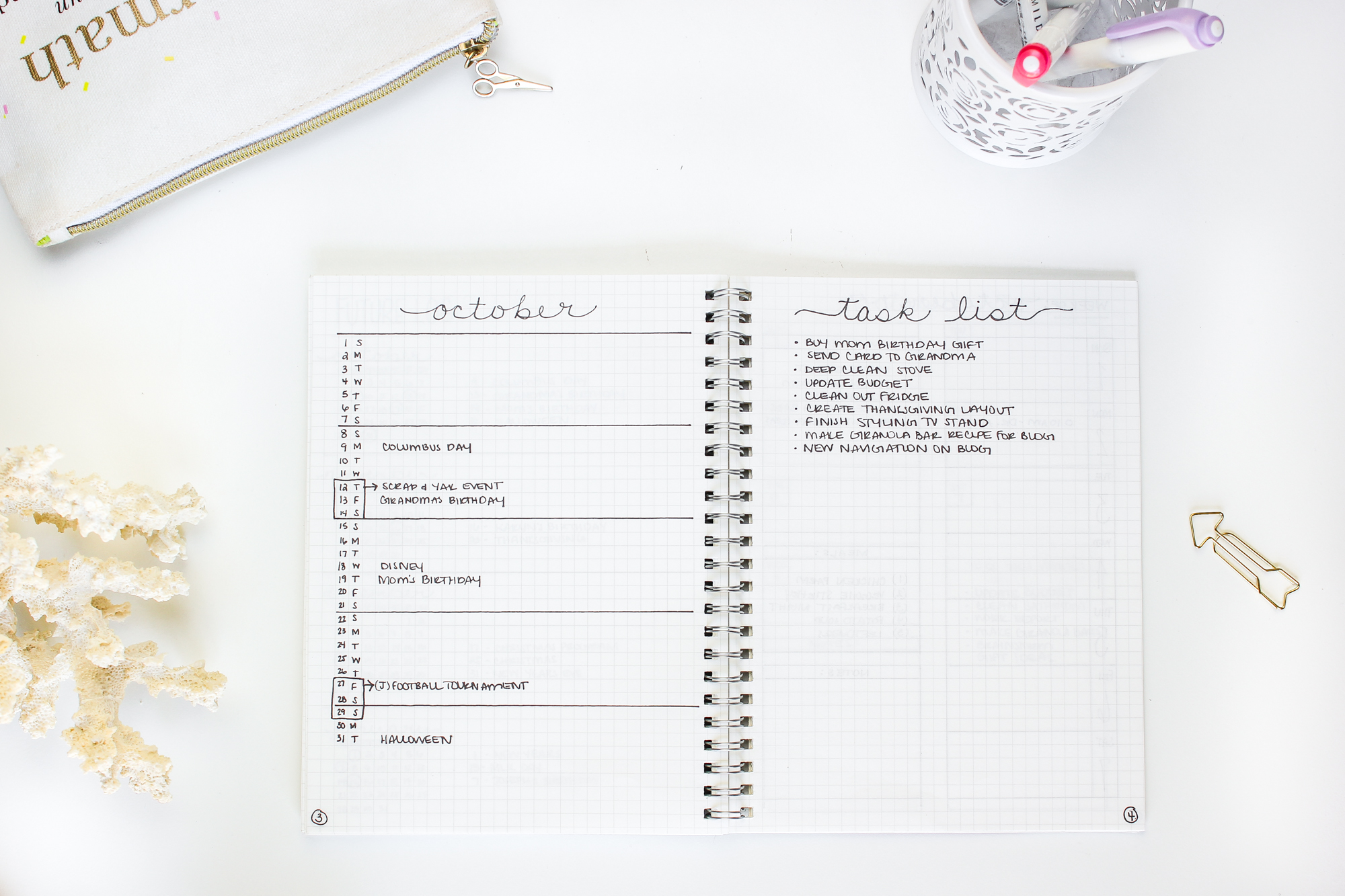
5. Daily Log
If the index is your bullet journal’s table of contents, your Daily Log is the main star. This is where you record your appointments and daily to-do lists alongside any movies or shows you watched, memories you want to record, the weather, meal plan, etc. Basically whatever you need to remember each day (or record for later!) goes on your Daily Log using the rapid logging method.
Because you don’t set up the next day’s list until you’re finished with the current one, you have as much room as you need to take notes and jot down reminders. This eliminates the need for extra sticky notes and papers. But I also love that if I have a really busy day, I can use a whole page, or a partial page with a lighter schedule.
And unlike a pre-dated planner, I can skip a day without leaving any blank boxes or pages! I just start another day on the next available page.
If you don’t complete all your important tasks on any give day, you can easily migrate that task to the next day with a small arrow.
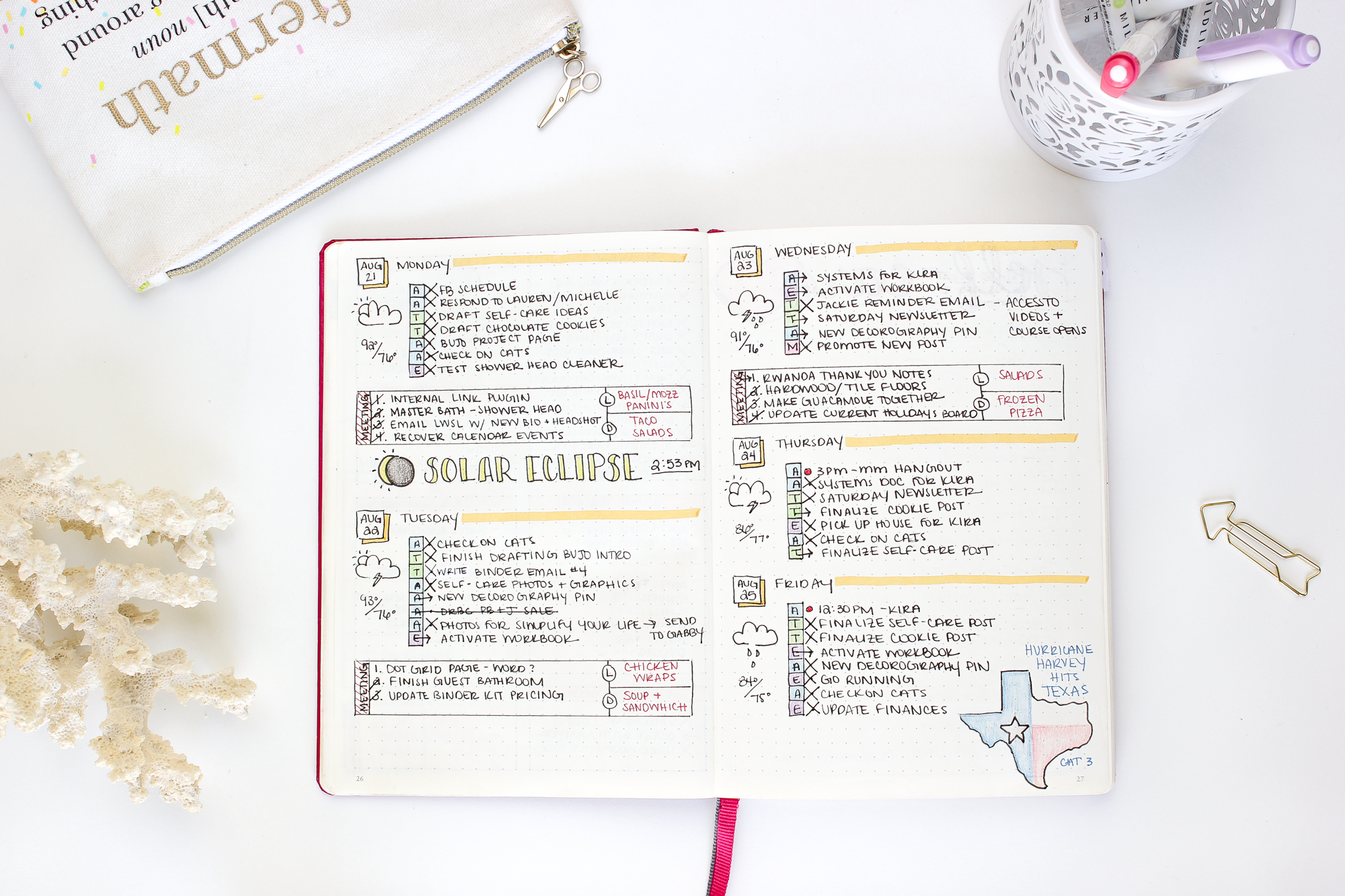
6. Collections
Collections are themed pages that you set up for a specific topic—like a list of books you want to read or movies you want to see. You can reference these pages on a long-term or short-term basis and add to them over time. Collections are a great way to store all those random lists!
Some people like to store their collections in the back of their notebook so they live together and add slowly work forward. Others just use the next available page and rely on the index to find what they need. Either way works!
Here are some ideas of what to include in your collection pages:
- Cleaning schedule
- Brain dump pages
- Gratitude log
- Mood tracker
- Workout tracker
- Habit trackers
- Shopping lists
- Favorite recipes list
- Long-term goals
- Online order tracker
- Bucket list
- and more!

Here’s a massive list of 101 bullet journal collection ideas (or you can click on the image below to grab the printable freebie!)
Read this post if you’re not sure how to manage collections when you move to a new journal.
But generally, you should think about what you normally track or would like to track on a regular basis. Some of these items you can dedicate to their own collection pages, or you can incorporate them into your monthly, weekly, or daily layout.
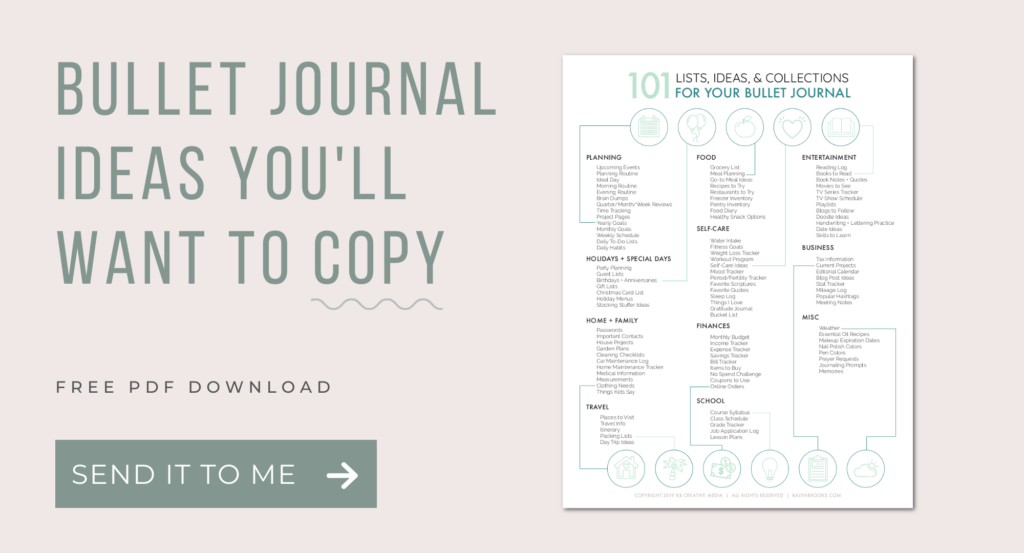
Speaking of a weekly spread…
7. (Optional) Weekly Log
The weekly log is actually not part of the original system, although most bullet journalists can’t live without them! These pages (usually on a two-page layout) give you an overview of your entire week with space to add your appointments, events, and tasks, along with a weekly meal plan or small habit tracker.
If you have enough room to fit everything you need on a weekly log, you may choose not to incorporate a daily log at all.
However, if you prefer a weekly overview AND a more detailed look at your day, you may want to use both! It’s really a personal choice.
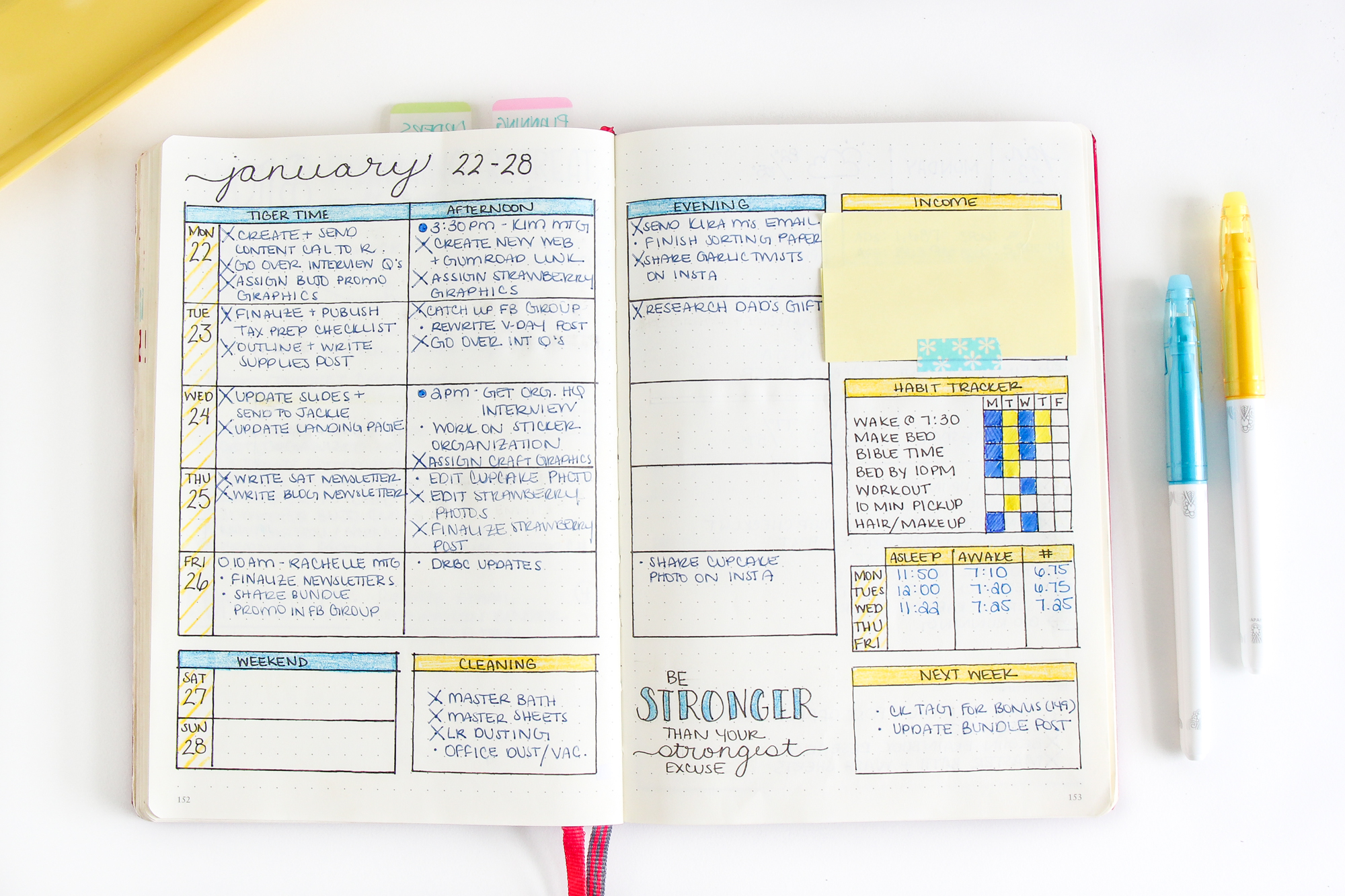
Read this post if you’re not sure whether you should use a bullet journal weekly log or daily log (or both!)
It’s hard to know what an entire bullet journal looks like when you only see bits and pieces through photos. If you would like a more in-depth view of how my bullet journal is set up, you can watch my flip-through video. (This was my second journal!)
How to Start a Bullet Journal (Best Practices!)
Maybe you love the thought of bullet journaling, but feel a little overwhelmed with where to start. You are not alone!
- The first few weeks felt a little clumsy. I wasn’t sure exactly what I was doing.
- Two months in, I started getting the hang of it and throughly enjoyed planning my days.
- Four months later, I finished my first bullet journal and purchased my second and third and fourth notebook (I think I’m up 9 or 10 right now!?) knowing that I wanted to do a few things differently next time around.
Here’s my best tips to help you dive into your bullet journal with confidence.
1. Purchase a Cheap Notebook (at First)
The best way to try bullet journaling is without a huge initial investment. I paid less than $7 for my first bullet journal—an EcoQua Spiralbound Grid Notebook (it costs more now thanks to inflation 🤪)—just to make sure I stuck with it.
And if I didn’t, I didn’t lose much money!
If you fall in love with the bullet journal method, you can be a little more choosey for your second journal. The Essentials Grid-Lined Notebook was my next journal and I loved that it was still affordable with slightly higher paper quality.
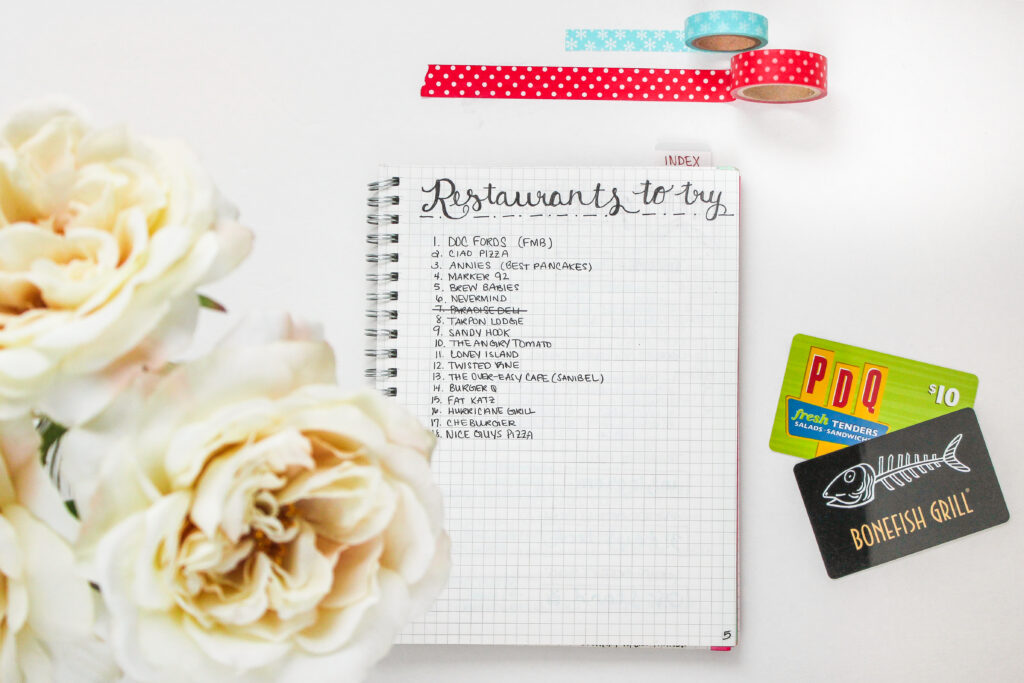
If you want to go ALL IN, here are the higher quality notebooks I recommend!
- Leuchtturm1917
- Scribbles That Matter
- Archer & Olive
- Hemlock & Oak (use code KBSAVE10 to save 10% off your order!)
People typically choose a dot grid notebook because it’s easier to draw straight lines, but you can also use a graph, blank, or lined notebook. It’s completely up to you.
2. Understand this is Your Learning Notebook
As much as you don’t want to make “mistakes”, you need to try different layouts before finding what works best for you. Don’t worry if you don’t nail your perfect setup on the first try!
Part of what makes bullet journaling fun and unique is the ability to tweak your layouts every time you turn the page. So don’t let your fear of the blank page keep you from trying something new.
You have to start somewhere… and who knows? You might really fall in love with bullet journaling!
3. Create an Idea Folder
If you ever get stuck, you can always look for inspiration on Instagram or Pinterest and save the layouts you like. I like to create a specific Instagram folder for each type of layout (daily pages, weekly pages, collections, etc) or you can screenshot the images on your phone and save them to a dedicated album.
Use these ideas as inspiration, not as the Bible. One person’s set up might work great for you! But it also might not. Consider what you love about this layout, then customize it to support your unique life season.
These are my favorite bullet journaling Instagram accounts:
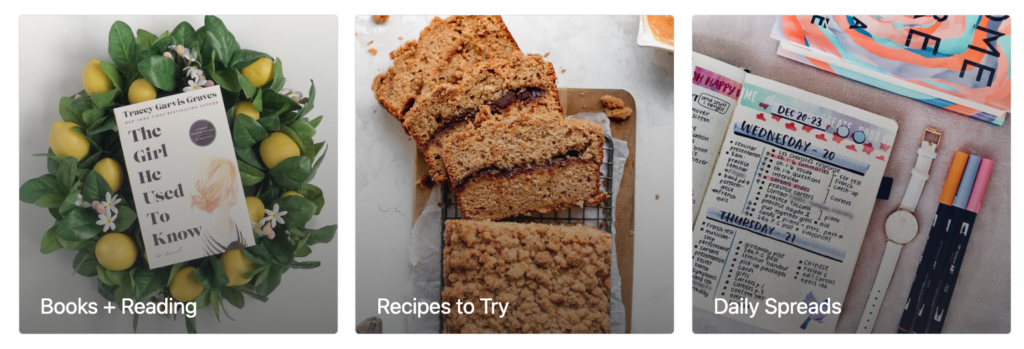
4. Start Minimally
Your bullet journal doesn’t even half of the pages you see online. Start with a simple setup that you can maintain consistently and add more later.
Here’s how I suggest you set up your first bullet journal.
- Number your pages if you didn’t buy a notebook with page numbers
- Set up your Index page
- Set up your Future Log or skip this layout and use a digital calendar instead
- Create a Monthly Log for the current month
- Set up a Weekly Log for the current week or skip the Weekly and just set up a Daily Log
- Choose 1-2 collection/list pages to add next.
Starting is always the hardest part. Once you get going, you’ll know what you want to change/add as you go.
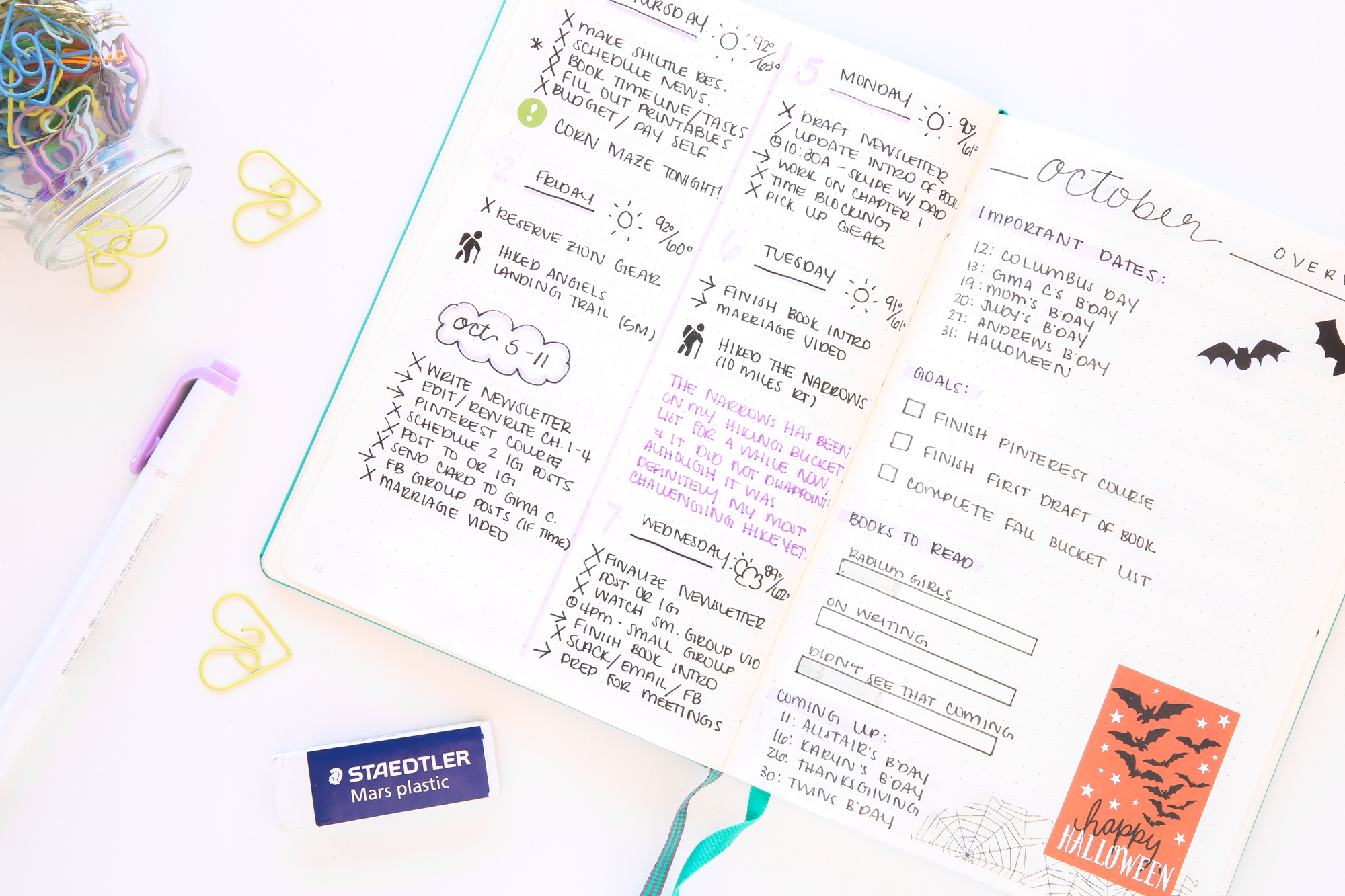
5. Sketch Your Layouts in Pencil
For more complicated layouts where you’re not sure how to fit everything on the page (at least evenly!), I recommend sketching in pencil first. That way, you know that you have enough space for what you need and can easily redraw if necessary. Later, you can go back over your sketch with a pen.
I prefer to use Faber-Castell Pitt Pens (size: S) and then grab a Staedtler eraser to remove pencil lines. Nothing smears with this method!
6. Flag Your Most Referenced Pages
The Index keeps everything organized, but there are some pages you might want to reference every day, multiple times a day—like a morning routine page or current project. I suggest using sticky tabs so you can flip to them fast.
The last thing you want to do is waste time searching for a specific page!
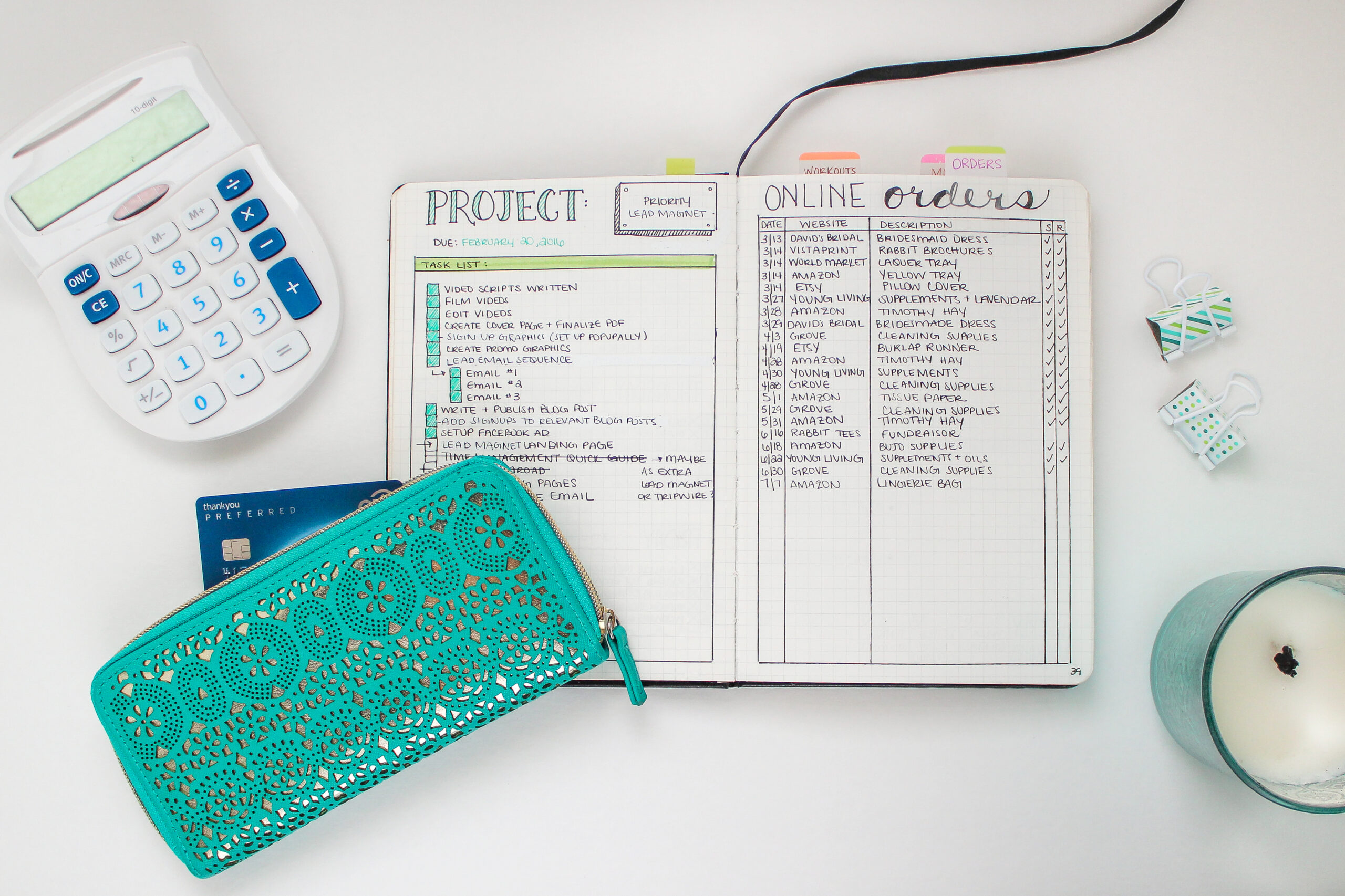
The Most Difficult Part of Bullet Journaling (But You’ll Get Through it!)
There’s a LOT of information on the internet about bullet journaling and you might be feeling really overwhelmed right now. This probably isn’t the first post you’ve read!
It’s much easier to get started if you’re not piecing information together.
I actually wrote a comprehensive step-by-step guide that shows you how to make bullet journaling work for your style and schedule without a lot of effort. It’s called, Brainbook: Bullet Journaling Your Way to a More Organized Life.
This guide is a total of 116 jam-packed pages, including setup checklists, beginner tutorials, and advanced tips and tricks. I don’t just show you how to set up your journal, I should you how to set your journal up for success, and maintain it going forward in a way that’s easy to understand and relevant to your life.
Bullet journaling has significantly changed my planning life for the better. My approach to it has morphed through the years, but I still adore the system!
The beauty is in the flexibility—you can adapt and change your bullet journal into whatever you need it to be. This the only planning system that allows you to evolve as you life season does and pivot quickly! You don’t even need to wait until the new year to start a notebook. So if you’re frustrated with your current system, you can quickly and easily jump into something new.
One more note: you don’t even need to track everything in your bullet journal if you don’t want to. Some people love that they can use ONE notebook to organize their entire life. And you can if you want to! But others, like myself, prefer to use a stack of productivity tools that integrate together.
Remember, I use Google Calendar instead of a future log!
I can’t wait to help you get started with your own bullet journal, so let me know in the comments if you have any questions about what I’ve covered here and I’ll try to answer them as best I can!
more posts about
Bullet Journaling
Have You Tried Bullet Journaling Before?
Or is this the first time you’re hearing about it? I’d love to answer any questions you may have!
Disclosure: Some of the links in the post above are affiliate links. This means if you click on the link and purchase the item, I will receive an affiliate commission. Regardless, I only recommend products or services I use personally and believe will add value to my readers. Read my full disclosure policy here.

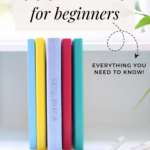


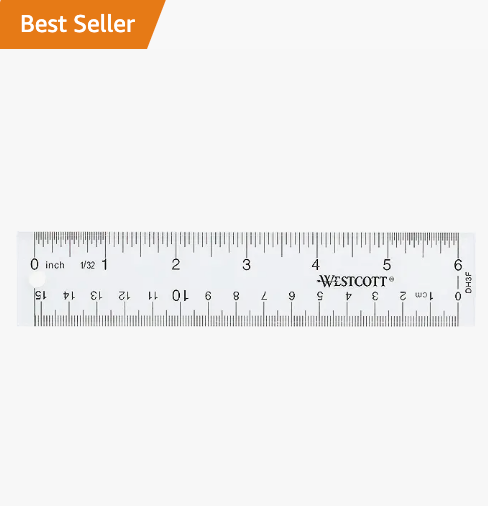

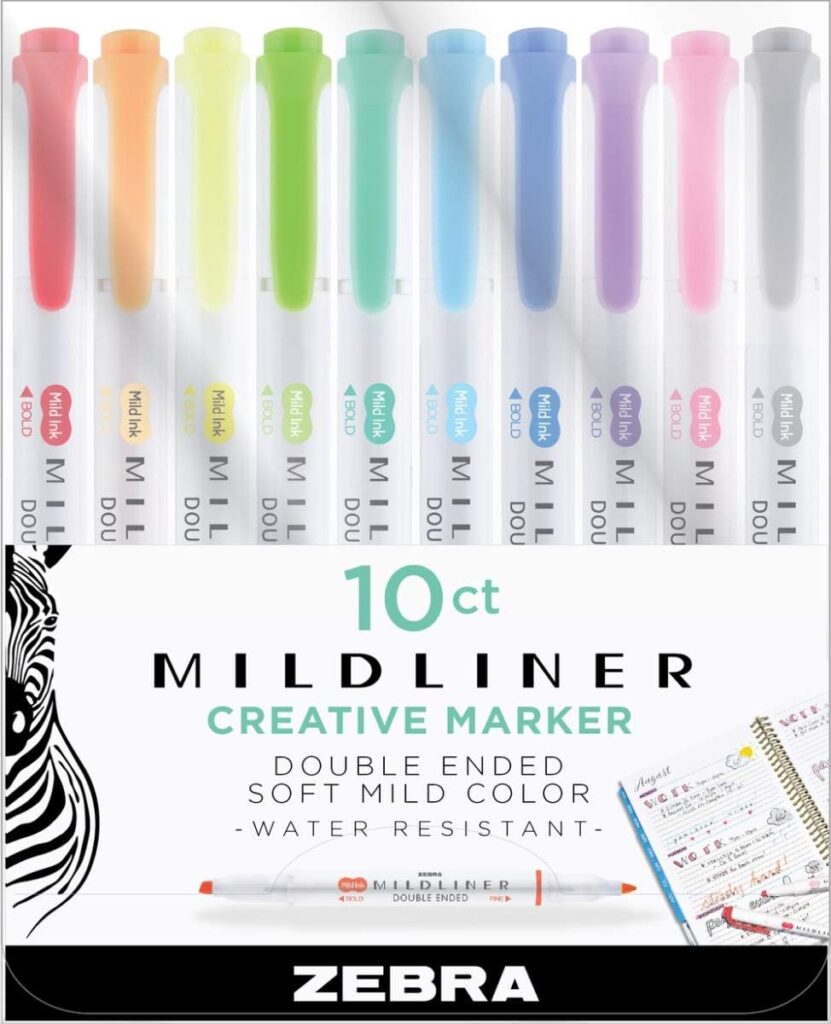
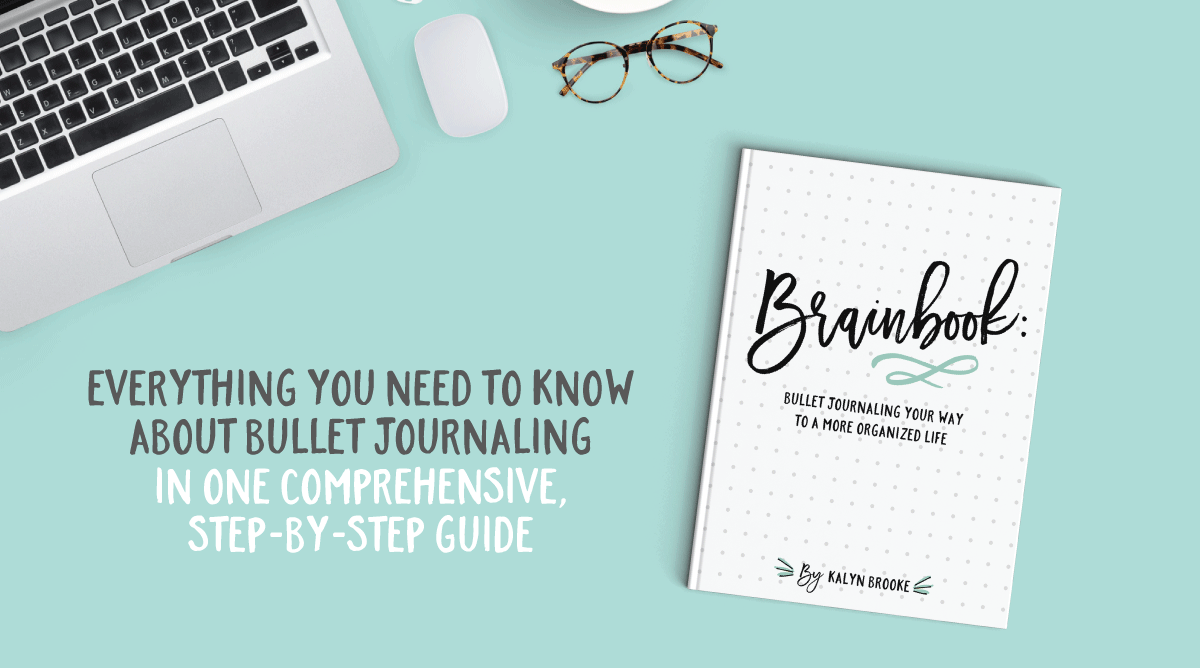
I recently started a bullet journal and all I have done is number the pages, make the index, and my bullet key I’m not sure which page I should do next and I’m afraid I’ll mess up and rip it out and then feel like the journal is ruined
Hi There,
Don’t worry about perfection (I know…that’s so easy to say and so hard to do – because I have to work super hard at releasing myself from that standard every day.)
You can always cross something out or even rip a page out. As you move forward in your bullet journal adventure one thing I would encourage you to do is not number a page until you use it. This will keep you from that worry. 🙂 I’ve ripped out more pages than you would probably think. Also – white out tape is your friend!
Does the paper in the Essentials Grid-Line Notebook allow ink feather, bleed, or ghost? I’m trying to find the perfect (inexpensive!) notebook.
Hi Anna,
It’s very thick paper and is the best notebook I’ve worked with {so far}. While I don’t think I can say it’s completely perfect, Paper Mate Flares and Fabre Castell pens worked really well with no ghosting. I haven’t tried a fountain pen on it.
I watched your video and your enthusiasm is infectious.
Your life is much busier than mine and I had a hard time in relating your journaling examples. I’m using your step by step suggestions for my journal
Thank you for your sharing with me
Hi Eva,
I hope that the step by step guide is helping you out. Everyone’s schedules and lives are so different, which is actually one of the things that makes bullet journaling such a good tool.
I’m working on starting a bullet journal but ironically, I’m so scatter-brained that I’m finding it difficult to recall everything that I would benefit from having included in it. I feel like my problem is that I’m so concerned with forgetting something that I’m trying to get too much set up at once.
Hi Lanie,
Just make sure to do two things.
1. Start small. Pick just a few things to work on. You are right, it can be really overwhelming to try to change a whole lot all at once.
2. Make sure to keep an index page. That will help you remember where things are.
You can do this! In time your bullet journal should really help you remember what you need to do and when you need to do it. The big benefit is that it should take away some of the anxiety of forgetting something important.
I have one question, what if you want your bullet journal to be as nice as yours, but you don’t know how to draw like that?
Hi Danielle,
Well, first I always encourage people to use a bullet journal for function before form. Make it work for you before you worry about making it look good.
But, for when you want to make it look good, that’s all up to you. Personally I don’t do too much, I add a few doodles, but when you compare it to those who make an art project out of their pages, mine are pretty simple. I’ve discovered that a few little doodles can go a long way.
If you purchase the Brainbook starter package, I include a doodle guide called Doable Designs that shows you simple techniques to easy doodles!
For all my boxes, I just use a ruler. 🙂 Keeps everything nice and straight.
I have had a bullet journal for a while, in conjunction with a LifePlanner. I love the system. So this year, I decided to get my 4 children and husband to try the system. Three of my children and my husband have ADHD and rely heavily on me to keep them organised, To start for my 3 ADHD children I set up bullet posters for school organisation to get them used to writing everything down, Then, I will help them migrate it to their journals. its a slow process changing their habits. My husband has been using his and has seen the benefits of what he calls his brain dump allowing him to concentrate on what needs to be done, He feels more confident at work and more organised. I had them all watch your video, I could see their brains going into overdrive with ideas:) SO, thank you for making the explanation easier for them to understand.
That is so awesome, Renee! It’s so exciting to see the people around you catch on to the benefits of Bullet Journaling. My husband got out of the habit last fall, but he picked it up on his own again just this last week and is tailoring it to some very specific goals that he wants to accomplish. I’ve got my fingers crossed for your family, and for Joseph that these will be life changing for them all! 🙂
Thank you so much for sharing your ideas…ive been doing bullet journaling for about15 years, and i didnt know it had a name…i like how u have the index , ive been trying to figure how to retreive or find infos i write which can be frustrating…again thank u.
You are so welcome, Ola! Now that you know it has a name – there is a whole new world of information out there if you search for it. 🙂
I keep looking into bullet journal because I like the customization options, however, I still need an appointment book for daily appointments and for planning throughout the year. Making the daily page every day won’t work, I need to be able to schedule some things months in advance. Any tips on how to merge an appointment book with bullet journaling without writing up an entire year of pages at once?
I completely understand your concern! Future planning takes some getting used in the bullet journal. However, there are a few options you can try:
1. Create a Future Log. This is a two-page layout where you can list out your months and jot down appointments and events under each month. Then when you create your Monthly Logs, you just look back at your Future Log and transfer those appointments over to your Monthly. You can see different examples of these if you search “Future Log” on Pinterest.
2. Use a calendar app to keep track of all your upcoming events and appointments, and let your bullet journal support your day-to-day as well as become the catch-all for your lists, notes, and ideas.
3. Combine the bullet journaling system with a paper planner. Disc-bound planners like The Happy Planner offer removable pages and often have a pre-designed calendar already included. Then you can add your bullet journal pages in between each monthly page and have the best of both worlds.
I hope that helps!
Are you sure you weren’t organised before? I love your bujo and it’s kind of overwhelming how organised it is haha, thanks for the video and the article they helped.
I really try to stay organized. 🙂 To be honest though, it’s just as easy for my life to get messy and disorganized as anyone else!
My strategy with my BuJo is function over form. I try really hard to find the system that works well…then I’m free to doodle. 🙂 {And, I’m constantly tweaking the system each week as I discover parts of layouts that work for my brain and throw out others that just don’t.}
What are the colored pens you use? Do they smudge? Do you use color only after you use the black pens, and do you have any problems with the pens bleeding through? Thanks so much, I love this idea.
Hi Kim,
You can Click Here to go to the colored pens! They’re amazing and don’t bleed through.
Hi Kayln!
Thanks for such a great overview of bullet journaling! It looks like something I’d love to try! I currently use the Living Well Spending Less planner and love it, but this method looks intriguing! I just might have to try it out! 🙂
What I really love about bullet journals is if a particular layout isn’t working for me, I can change it! Whenever I have a planner I end up with so many wasted pages where I find out a month or two into the year that part of the system just doesn’t work for me. You should absolutely try it. The worst thing that can happen is you don’t like it and go back to planners. 🙂
Hi!
This was so inspirational and very good explanation of what bullet journaling is. I am gonna go your way BIG thank you of this video!!
Regards from Finland,
Maarit
You are very welcome! I’m so happy that you found it helpful.
Kalyn – thanks for your post about your bullet journal. It was thorough yet concise and left me much less overwhelmed by the idea of expanding my little red notebook.
Hi Delana, I’m so glad you found my post helpful! When you see all the options a bullet journal provides it really can feel like too much! Just tackle one layout or tracker at a time until you have perfected the system that works best for you!
Hi Kalyn, I started a bullet journal and I can appreciate the beauty of your journal. :o) This is testing my crafting skills. A couple of questions: 1) The page headers Index, Projects, etc., are these done with a stencil or freehand? If stencil, which one? 2) In coloring in some letting the markers I used bled thru to the back of the page. Is there a specific marker that should be used so they don’t bleed or use color pencils? Thank you.
Linda
Hi Linda,
The black pen I use is the Faber-Castell PITT Artist Pen. You can get it from Amazon, or if you don’t want to wait for it, of have a coupon, you can pick it up at Micheals.
The highlighters are a bit harder to find because it’s a Japanese brand – Mildliner. Thankfully they are available on Amazon!
The cool thing about the Mildliners is that not only do they not bleed through like most markers, they have a bold tip, and then on the other side of the same pen they have a fine tip too.
Hello, those tips are amazing. I have tried several times to find a palnner that would suit me. Also my downside is I am not artist, so everything I am trying to create looks so basic. The crucial point of creating my own diary is the fact I have a problem to keep up as you need to create the layouts and continue adding them. I have to say you tips are amazing and I trully like the way you make your journal/diary. You boost my interst and I will try work on it. Thank you for great tips.
Hi, Kayln!
Thank you SO much for sharing this video of your bullet journal! I don’t know how many hours I have spent recently on Pinterest searching for the right simple layouts to use to start mine. I FINALLY found this post with your video. It gave me the confidence and tools to start bullet journaling simply, which is what I was looking for. I do love doodling and adding fun graphics and such to my work, but I wanted to start out with something that I could do easily and quickly until I get the hang of what exactly works for me. I am going to be doing a Beginners Bullet Journaling Mini Course on my blog soon, as there seems to be a huge interest in bullet journaling, and I can see why! Would you mind if I mention this post and link it to my post/course? I’d love to know what you think of my blog if you have a moment to stop by. Thanks again and blessings!
Hi Sara,
By all means you can link to my post. I’m so glad you found it helpful.
Hi! I’m trying to get my bullet journal together and having a hard time just making an order of things which stops me from working on it. Where do you put your lists – as in important ones – ones that may follow over to the next bullet journal for example: wish list, travel bucket list, favorite movies, favorite products to remember, etc things like that. Do they go between month layouts? Week layouts? Thanks
Even though it feels unorganized, I put all my lists and collections on the next blank page. In other words, I never leave blank pages as I progress through the journal. However, {and this is the key} I always keep my index in the front of the journal up to date so that I can always find a list when I need it.
For instance: my TV show, list that keeps track of what episodes I’m on, is on page 12 right after a weekly page. I never have any trouble finding it though because it’s indexed.
I know this may feel unorganized at first, it really did to me too, but now that I’ve gotten used to the system I really don’t ever see myself going back to a traditional planner.
You certainly make it seem a lot easier – think I was think too far ahead certainly going to try your way
Thank you, Sandra. I can fall into that trap of getting too far ahead of myself too. To help keep that from happening, if I have a big project {that is going to take a long time and has several steps} I create a specific project page with all the steps and due dates broken down. Then when I’m doing my daily pages I reference any project pages I have and make sure to add any of the broken down steps to that day’s to-do list.
I hope that helps! I’m going to be putting some more BuJo content up here soon, so be sure to come back. 🙂
What pens are in the lists and collections picture???? I want some!
They are my favorite colored pens! Here’s a link: Assorted Color Millennium Pens.
Thanks for this detailed post. I just purchased a journal today and I’m about attempt bullet journaling for the first time!
That’s so exciting!
I was so excited to get home from work today because I knew that my bullet Journal supplies were waiting for me from Amazon. I just discovered bullet journaling a couple weeks ago and I can’t wait to get started. thank you for your input
That’s so exciting! There’s almost nothing better than having something from Amazon sitting at your door. 🙂 It’s kind of like Christmas, where you know what the gift is ahead of time but you can’t wait to open it anyway!!
I’m very excited to start this but I feel I will make it too complicated and not stick too it. I’m currently on Mat leave. But I also have a toddler. I’m a teacher, but am considering starting a home daycare. I have notes all over the house and on my phone. I like writing and making notes, this seems like a great idea for me. But how do I not overwhelm myself. and where do u find the time??
Hi Leslie,
Just like any planner, it’s about setting up a routine. I spend a few minutes each night making my to-do list for the next day. Then on either Saturday or Sunday night I spend a bit more time doing the Weekly Spread and any other special Spreads. I’ve found I can often do this while watching a show with my husband, although sometimes I just do it on it’s own. It does take a little time, but I’m sure having an organized to-do list and not searching around for where I put sticky notes has actually saved me time in the long run!
I’d encourage you to start small and focus on function over creativity. You could even skip the weekly spread and just start with a daily page. Put your to-do list on it the night before, and then jot any notes down on it throughout the day. As you get more comfortable start seeing if the weekly spreads and habit trackers work for you too. One of the best parts is that if you miss a day or two, you just pick up where you left off, leaving you with no wasted pages like a pre-done planner.
I loved you video and ideas for bullet journal. I have been doing a bullet journal for about a year and getting ready to start a new one. I will definitely be trying some of your ideas.
Thank you
This is so great and creative! I am going to try this, thanks!
Have fun with it!
Wow these are gorgeous! Super creative! Thank you for sharing this 🙂
xx
Awesome! I’m excited. I’m inspired. I love my Erin Condren Life planner BUT I think a bullet journal will be really productive instead of JUST cute. Thanks.
I have never enjoyed a planning system more than this! 🙂
I’ve seen a lot of things about bullet journals lately, funny thing is I used to do this many years ago and was so productive, then I got lost in trying to find a planner that was already made for me, thinking it would save me time. But, it was your post that made me realized I needed to get back to this. Hope you don’t mind the shout out on my post: http://domesticdeadline.com/2017/01/04/getting-organized-step-by-step/
Of course I don’t! It looks like you have big plans for 2017!! 🙂
This is a great starter article. I have over – researched and am having “drinkofwaterfromafirehydrant” syndrome. You helped me re-focus. This is my first time here from pinterest. I’ll be back.
Oh I am so familiar with that syndrome! I think it’s a common one to have in the internet age. I’m so glad some of my experiences from bullet journaling was helpful!
Hi Kalyn,
I’m loving the idea of bullet journaling, but my only concern is the time it takes to manage. Can you tell how much time you invest in managing it, and do you think it will work for individuals that have never really been a planner person?
I’m definitely intrigued!
Thanks so much!
It does take some time to manage, but not as much as you would think. Each night I spend about 10 minutes planning out the next day, and then on Sunday night I spend 30 minutes or so planning out the next week. Sometimes I spend more time, but that’s just if I’m having fun with trying out fancy fonts, which isn’t a requirement for bullet journals. 🙂
As far as for the “non-planner person” it’s definitely a better option because you don’t feel constrained to boxes and layouts that you won’t use. Also, if you skip a few days because life gets in the way, you can just pick up where you left off without wasting any paper. I can say that my husband, who easily fits into that category, is starting to convert over to it. We’ll see if it sticks!
If it still feels overwhelming to you, just start by making daily and weekly to-do lists. This will help you figure out whether or not you want to take it further.
Hi Kalyn! (English is not my native language so I am sorry for my grammar and not only grammar mistakes)
I saw your journal few months ago, and I was really inspired, so now I have my own BJ, and now I’m surfing the Net for some new ideas for it. And I understood that your journal is the most convenient and elegant(for me, it’s the best) I’ve ever seen. And I do really say it from all my heart, thank you very much for inspiring new and new people:) really want to hug you
Awww. Thank you so much Maria. You are too kind! I really hope you get a lot of enjoyment out of your bullet journal!
Good Day Kalyn!!
So Super Awesome to come across your blog/video, today!
I’m a fellow BUJO Smashbooker (started in January 2016 and LOVIN it!) <3 I'm always looking for creative inspiration for my closed FB group, Barefoot Journaling Chronicles! Your post here will be a HIT esp for my new members wanting to give bullet journaling a try. Happy to showcase your ideas!! Will be starting my own blog soon. Been building my group since April 21, 2015 to a hefty 426 as of today from a charter membership of 5…humble beginnings.
Would love for anyone reading this or You to join us if you'd like…be happy to have you with us. 🙂
AWESOME post!! Will be snagging some of your cool ideas!!
Blessings!
~Evon Robinson
Barefoot Journaling Chronicles
Wow, thank you so much for this post! I’ve been keeping bullet journal for two months now, but it’s still a bit of a mess 😀 But thanks to your tips I can see where I went wrong.
That’s actually one of the things I love about a bullet journal, it’s constantly evolving to my needs and I keep getting more efficient with it as I go. I’m so glad you found the post helpful!
Thank you for sharing this. I have a quick question, I guess two questions :). So before each month do you set up your monthly and weekly page first? Then set up your daily as you go along each day? Where do you insert your trackers? You must put them at the beginning of the book since you are tracking them at the beginning of the year. But if somewhere in the middle of the a month you decide to track something, do you just flip to the next page and insert a tracker page?
I just watched your video and it answered both my questions 🙂 great video! Thanks again for sharing!!! Great job!
I’m glad the video helped you out! Good luck with your bullet journal.
Thank you! I was meaning to begin a bullet journal a long time ago. But I was exploring different option and they all seemed to be so complicated! I just came to your blog through Pinterest and I loved how easy you make it look. Watched your video and I liked the simplicity of your explanation and also how well organized is. I’m starting mine as of today ^_^
Good luck, Georgina! I’m just finishing up my weekly spread right now. I’m even experimenting with a couple of new layouts this week. 🙂
Bullet Journaling is new to me. In the last week, I saw a YouTube video and heard it mentioned and watched that person’s video. I’m not artistic by any means, but I LOVE to plan and write things down. I just started using the Living Well Spending Less planner, but still use a separate notebook to jot things down, plan, etc.
You are definitely piquing my interest!
PS – I’m only worried about being OCD with it ; )
Hi Gina!
Think of your first {and maybe second and third 😉 } bullet journal as a practice journal. That should keep you from getting too wrapped up into the details. Experiment with new layouts and try out ideas that you’ve seen online. I actually just tried out a new layout this week – but I don’t think I’ll ever use it one again. That’s really what I just love about them, I’m never “stuck” with something that I don’t like.
Great overview! I love some of your blogging pages and might adapt them to my own Blog Bujo. Thanks for linking to my IG!
Thanks so much for being a huge inspiration!!
Hi! Love your post. I had a quick question though. When you start another bullet journal after filling out the first one what do you do about all your lists? Do you copy them all over?
Thanks for the great content,
Amanda
Hi Amanda!
When I switched over to my 2nd bullet journal, I only transferred a handful of lists that I needed to reference long-term. It actually was a good exercise to do, because there were different ways I wanted to set up my lists after I had been journaling for a while. And like I said, I didn’t need to transfer all of them.
Also, you can reference lists in your index from previous bullet journals if you don’t need to access them all the time. Just make a note that it’s in Bullet Journal #1, Page 21 or something like that.
Hope that helps!
I can’t tell you how many times of watched and re-watched this video. It’s so inspiring, Kalyn! Thanks for being the first person to introduce me to bullet journaling and for giving us this glimpse into your pages. Just added a project planner tonight…plus a task list for my first project breakdown. I know this is going to be such a helpful tool for me as I tackle some big projects this fall. Your pages are simple, beautiful, and so well thought-out. Thanks for taking the guesswork out of layout for us!
Aww. You’re too kind, Lauren! I honestly don’t know how I lived without my bullet journal, and especially the two spreads you mentioned. I can’t wait to see what you do with yours!!
Your bullet journal is gorgeous, Kalyn! And I’m even more intrigued now. Thanks for sharing yours and giving us a peek inside. If / when I take the plunge, I’ll owe it all to you! 🙂
You’re too sweet, Kristen.
Bullet journals are so cute! But I also have chicken scratch for handwriting, so there’s that. I’d love to start one just for fun and put reminders and such in there!
There are many people who use bullet journals as a creative outlet, but there are equally as many who love them just because they are a great way to organize your thoughts! The best part is no one cares about penmanship when it comes to getting organized. 🙂
I want to make one but unfortunately my graphic skills are not on fleek.
Haha! You don’t have to be an artist to do a bullet journal! Sure, you can make them prettier with scrollies, fancy fonts, and scribbles, but that’s not what a bullet journal is all about. At least for me. It’s primary purpose to to be an organizational tool! You can organize your life by just drawing boxes and writing in your to-do’s and schedule. It’s amazing how much it helps me accomplish my tasks each day.
Just find some Bullet Journal Stencil Painting Shapes Letter Journaling Set On Amazon for us without graphics skills 😉
Dont let your handwriting hold you back. I let my awful handwriting and limited art skills stop me for awhile, but im sp glad i finally decided to just try it. My journal isnt as pretty as the pictures you see, but its so useful.
I am too scared that I will rip out pages and get angry at myself if I make a bullet journal mistake. Any tips?
Hi!
That is a GREAT question. I struggle with the same thing, and even though I’ve been doing my bullet journal for a long time now, I still find myself occasionally ripping out a page that I’m not happy with. Keep your eyes open for a product that I’m launching in just a couple of weeks that has a section devoted to this very topic! I’ll give you a sneak peek tip though. 😉 One of the keys to bullet journaling is focusing on function over form. In otherwords, free yourself from the perfection of having an “Instagram worthy” spread and focus on making the journal “work” for you. Then, if you want, once you start getting the hang of the functionality you can start working on making it look prettier.
A couple ideas if you do make a mistake though, is to use washi tape or a fun sticker to cover it up. I’ve done this multiple times and love the look even more than if it was perfect.
That’s just a tiny sample of what’s to come though!! Stay tuned!
Thank you Kalyn! Still a bit nervous. Also, what is the best notebook to use?
Thanks Kalyn.
If you’re looking for a budget friendly option, the Essentials grid-lined notebook (http://amzn.to/2iLFSSs) is a quality notebook and a great place to start! If you have a little bit more you can spend, no one has ever regretted the Leuchtturm 1917. (http://amzn.to/2hNZkNt) The pages are super smooth and are numbered, which means you don’t have to number them yourself. 🙂
I just had to write this in my bullet journal as a reminder to myself– “Pinterest is pretty, but they’re PAID to be pretty, so try for practical instead.”
Unless you’re planning to start a BuJo blog and pinterest page, it doesn’t have to be this pretty. It’s for you and you alone, so as long as you can read it and enjoy using it, who cares what it looks like?
When you are bullet journaling, function is more important than cute designs.
Yeah…..rip it out, get angry, get over it and start over, but like the sneaker guys say…..just do it! You will never know or get good until you try.
Sorry, don’t mean to be brash (?) here, but I can’t tell you how many knit/crochet projects I ‘ripped’ out and started over. Mistakes are part of the process. You got this!!!
Sometimes the “Get Angry” part comes before the “rip it out” part. 😉
Another super important thing is learning to give yourself permission for a page to not be “perfect.” This is especially true when you are trying out new layouts. Sometimes you think something was a mistake, and then throughout the day or week you may find a part of that “mistake” that is actually a good system, or gives you more ideas of things to try.
I use a small 3 ring binder I found at staples (5×7), they also had paper and dividers to fit it. That way I can move list pages around/redo so they make more sense to my brain and not worry about I-might-have-rip-it-out syndrome! Another HUGE bonus is that I (finally!!!) found a weekly planner page that suits me very well so I just print those out, hole punch them, pop in my binder, and fill them in. If I had to ‘draw’ my planner page every week I’d get so behind! Loving my system, it’s doable, pretty, easy to set up, and easy-peasy to keep up! 😊
That’s awesome, Jennifer! It’s all about creating the system that works the same way your brain does. 🙂
I did something similar by printing out pages from Outlook (including birthdays and anniversaries prefilled on the appropriate days of the year so I didn’ have to rewrite them every year), and then created computer forms for things I wanted to track. my problem is that it ends up being a little bulky to always be carrying around ….
Great idea for birthdays and anniversaries Robin! I find myself taking out my 2 weekly pages and tucking them in my purse to take along to work, it’s not ideal if you care that your pages get a little crumpled 😜 but those get tossed after every week anyway, another reason I love the 3 ring binder, my weekly appointments/to-do’s don’t need to be kept once the week is over. I simply transfer my week’s habits onto a monthly habit tracker page, and move over any not-yet-done to-do’s onto the new weekly page before tossing the finished one. The pages go back in the binder when I’m home. I don’t feel the need to carry a whole binder/journal in my purse, it’s just too bulky, but being able to bring along 2 small pages is convenient and easy! 😊